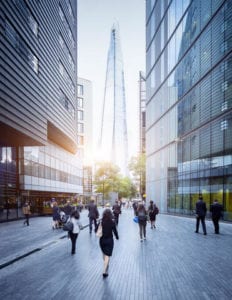
In my previous post of this commercial buildings series we reviewed ways to optimize operations during low occupancy to ensure service continuity, occupant safety, and operational efficiency. As local restrictions are relaxed in many regions, commercial building owners and tenants are now preparing for employees to return to work, whether that will be at partial or full capacity.
After an extended period of low occupancy, it’s important to coordinate a smooth reopen to support safety, maximum efficiency, and readiness once the building reopens. These steps are also important to give occupants the peace of mind that precautions have been taken for their own personal safety and wellness.
Prepare for Your Commercial Building Restart
Let’s have a quick look at some key steps you should take. For more comprehensive guidance, download our Application Note: Returning Your Smart Building to Normal After Periods of Low Occupancy.
1. Optimize HVAC
Heating, ventilation, and air conditioning (HVAC) may need to restart several hours before occupants and employees arrive, with setpoints revised from pre-building closure schedules. Remember that work schedules may be altered for lower occupant density while automation should take into account the season and external conditions. Occupant comfort and well-being should be a priority – remote monitoring software can help. Read this post for more in-depth information on HVAC considerations for disease control.
Next, return the cascade of boilers back to normal running mode. Chiller operation must be checked before opening day using alternate sequence, and cascade of chillers should return to normal. Similarly, operation of exchangers and distribution pumps should be checked, and both returned to regular automation control.
Following a health crisis, it’s critical to optimize ventilation and airflow to promote good indoor air quality. The proper operation of each air-handling unit must be checked, and a pre-occupation scenario launched several hours before the reoccupation period. Temperature and humidity should also be carefully set.
Advanced analytics platforms and sensors may be used to identify areas with sub-optimal air quality. Software solutions for commercial building operations and continuous commissioning can help proactively identify issues impacting comfort and well-being, while allowing for remote and proactive maintenance.
2. Reset lighting
Regular lighting control scenarios for all zones should be reactivated, with time schedules set correctly for a return to normal.
3. Manage security
Security systems and personnel play an important role in maintaining acceptable occupancy levels and ensuring building rules are followed. This includes access control authorizations, and accounting for off-limits areas. There may also be a need for contactless entry and additional screening (e.g. survey, temperature checks).
Guard tours should resume, with guards fully informed about new rules so they can inform occupants and visitors. Guards may need to ensure appropriate people flow, thermal checks and even questionnaires are answered by returning occupants and employees. Video surveillance should continue, and operation of fire security systems should be checked.
Times of change can also be opportunities for cybercriminals, so cybersecurity practices should return to normal. For an in-depth guide on cybersecurity for your smart building control systems, we recommend reading “A Practical Framework for Cybersecure Smart Building Control Systems.”
4. Manage energy use and production
While no specific power distribution actions are required as daily loads return to normal, the organization should consider taking advantage of power management software, which is sometimes embedded in building management systems. During normal operations, this tool can simplify the steps needed to optimize energy efficiency, reduce energy costs, and document improvements in energy conservation. If smart building software is being used to monitor consumption of energy and fluids, it should be reset to its regular configuration for alarms reports, and dashboards.
If your commercial buildings have renewable energy sources onsite, such as solar photovoltaic with on-site storage or geothermal, these systems should be checked to confirm their full functionality upon a return to normal.
5. Other commercial building considerations
Following a global health crisis, some other considerations can be just as important to health and well-being as the functioning of traditional commercial building systems. For example, desks may need to be spaced 6 feet apart, additional signage may be needed to indicate entrance and exit lines and spacing or to share new procedures such as when and where masks are required or how many people can now be safely distanced on an elevator together. Sensors and apps can indicate available desks, or may also be used to mark desks as unavailable. Plexiglass windows or panels may need to be installed on low-walled cubicles to prevent the spread of viruses.
It will be important to clean and sanitize regularly touched surfaces, e.g. elevator buttons, doorknobs, desks, and other surfaces. Occupancy analytics may be used to optimize cleaning runs. In restaurants, secure a safe distance for cafeteria tables and food handling, while regularly cleaning and sanitizing food counters, tables, and chairs. Accommodations may need to be made to avoid contamination of silverware and other frequently touched objects in the food service area. Additionally, patios and outdoor spaces should be reconfigured for maintaining an appropriate distance.
Employee communication prior to and during building re-entry will be critical, especially if new rules and procedures are to be implemented. Be certain that these policies are reflected clearly on digital signage for the sake of employees, customers, and visitors and that employees are given information prior to their arrival at the office.
Read our application note to see further recommendations. To learn more about connected products you can use to help restart and efficiently operate your buildings, visit EcoStruxure™ for Commercial Real Estate.



